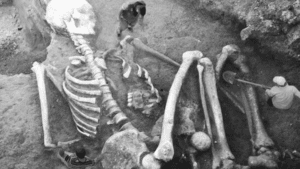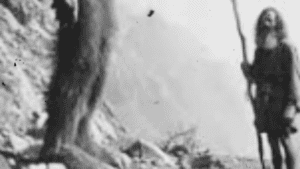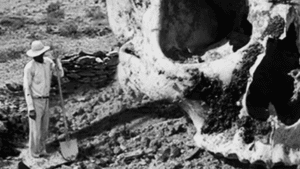Step back in time to the Wild West, an era of cowboys, outlaws, and larger-than-life legends. Amidst the tales of gunfights and gold rushes, a captivating mystery unfolds, stretching the boundaries of imagination. Imagine yourself in Lovelock, a quaint town nestled in the Nevada desert in 1911. Deep within a narrow cave, two brave miners embarked on a quest for bat guano, unknowingly stumbling upon a discovery that would shake the foundations of history.

As their lanterns pierced the shadows, the miners beheld an astonishing sight—over 40 human skeletons, some reaching an incredible height of 7 to 8 feet. These were no ordinary remains; they towered above the average men of their time. Hold onto your hats, for the intrigue deepens—these giants possessed a peculiar feature: red hair. Yes, you heard it right; the skeletons of Lovelock Cave were often found with fiery locks adorning their colossal skulls, setting them apart from the Native Americans who inhabited the region.
The news of this extraordinary find spread like wildfire, capturing the imaginations of people far and wide. But Lovelock Cave held more than just bones; it yielded over 100,000 artifacts, many of them gigantic in size. Picture sandals that could fit a foot 15 inches long, equivalent to a whopping size 29 in modern US measurements—almost tailor-made for a 9-foot-tall individual. There were even colossal pieces of clothing that seemed to have been worn by giants themselves.

Now, you might think giants in the Wild West sound like something out of a tall tale, but the truth is stranger than fiction. Reports of giant discoveries were not uncommon during those rugged times, tapping into a deep well of belief intertwined with biblical lore. The Bible spoke of a time when giants roamed the Earth, and for many, stumbling upon these skeletal remains felt like tangible proof of ancient biblical tales merging with history.
Delve deeper into the lore surrounding these giants, and you’ll find the indigenous Paiute people, who called the Nevada desert home for centuries, held their own account of a momentous battle with a race of giants called the Sai duah. According to Paiute legend chronicled by Sarah Winoka, a descendant of Chief Wiuka, these red-haired giants lived in the mountains near their nation and were known for their cannibalistic tendencies.

The Paiute people, weary of being on the giants’ menu, waged a war lasting a staggering three years. The conflict culminated in the Paiutes cornering the giants in Lovelock Cave. Picture Paiute warriors determined to rid their land of towering cannibals, gathering brush and firewood to block the cave’s entrance. They set it ablaze, sealing the giants’ fate within those fiery depths.
In 1911, when the discovery was made, evidence of massive burning near the cave’s entrance mirrored the Paiute legend. It was as if history had unfolded exactly as the tale had been told. Yet, Lovelock Cave wasn’t the sole stage for the echoes of giants in the Western Nevada desert. Reports of giant bones and artifacts surfaced time and again—an 11-foot-tall skeleton in 1904, an 8-and-a-half-foot skeleton in 1931—the evidence abounds.

As we reflect upon the tales of the Paiutes, the discoveries in Lovelock Cave, and the countless reports of giants in the Wild West, we’re left with a lingering question: Could there have been a race of giants who once roamed this land? Are these stories and skeletal remnants the echoes of an ancient truth hidden beneath the layers of time?




